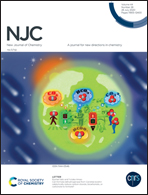Theoretical study of two-dimensional bis(iminothiolato)metal monolayers as promising electrocatalysts for carbon dioxide reduction†
Abstract
The design of highly stable, effective, and selective electrocatalysts is essential for electrochemical reduction of carbon dioxide (CO2). Here, on the basis of density functional theory (DFT) computations, the reaction mechanisms of the reduction of CO2 over a series of bis(iminothiolato)metal (TMIT, TM = Mn, Fe, Co, Ni, Cu, Ru, Rh, and Pd) were studied. It is found that the CO2RR activity of TMIT depends on the choice of the central metal atom. Our results demonstrated that HCOOH is the main product for TMIT (TM = Mn, Fe, Co, Ni, Cu, Pd). Among them, MnIT and FeIT are promising CO2RR catalysts for the HCOOH production due to the good selectivity and catalytic activity with the low overpotential of 0.34 V and 0.35 V, respectively. For RuIT and RhIT, the main product is CO, and the strong adsorption of CO on the catalyst surfaces would poison the catalysts. This makes RhIT and RuIT not good CO2RR catalysts. We anticipate that this work may shed new light on the development of high-performance metal organic framework (MOF)-based electrocatalysts.



 Please wait while we load your content...
Please wait while we load your content...